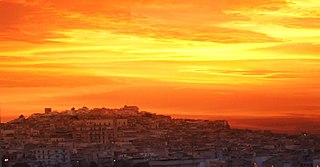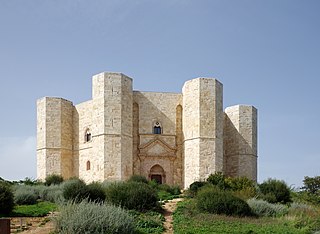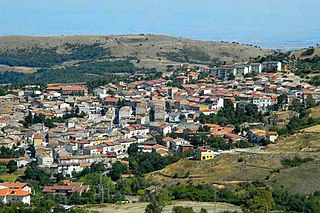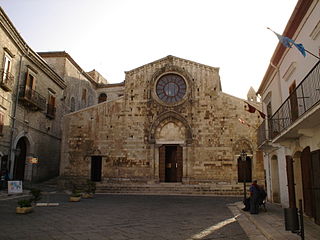Castro is a Romance language word that originally derived from Latin castrum, a pre-Roman military camp or fortification. The English-language equivalent is chester.

Canosa di Puglia, generally known simply as Canosa, is a town and comune in the province of Barletta-Andria-Trani, Apulia, southern Italy. It is located between Bari and Foggia, on the northwestern edge of the plateau of the Murgia which dominates the Ofanto valley and the extensive plains of Tavoliere delle Puglie, ranging from Mount Vulture at the Gargano, to the Adriatic coast. Canosa, the Roman Canusium, is considered the principal archaeological center of Apulia, and is one of the oldest continually inhabited cities in Italy. A number of vases and other archaeological finds are located in local museums and private collections. It is not far from the position on the Ofanto River where the Romans found refuge after the defeat of the Battle of Cannae and is the burial place of Bohemund I of Antioch.

The province of Foggia is a province in the Apulia (Puglia) region of southern Italy.
The Archbishop of Nazareth is a former residential Metropolitan see, first in the Holy Land, then in Apulian exile in Barletta, which had a Latin and a Maronite successor as titular sees, the first merged into Barletta, the second suppressed.

Foggia is a city and former comune of Apulia, in Southern Italy, capital of the province of Foggia. In 2013, its population was 153,143. Foggia is the main city of a plain called Tavoliere, also known as the "granary of Italy".

Andria is a city and comune in Apulia. It is an agricultural and service center, producing wine, olives and almonds. It is the fourth-largest municipality in the Apulia region and the largest municipality of the Province of Barletta-Andria-Trani. It is known for the 13th-century Castel del Monte.

Cerignola is a town and comune of Apulia, Italy, in the province of Foggia, 40 kilometres southeast from the town of Foggia. It has the third-largest land area of any comune in Italy, at 593.71 square kilometres (229.23 sq mi), after Rome and Ravenna. In 2017, it had a population of 58,534.

San Severo is a city and comune of c. 51,919 inhabitants in the province of Foggia, Apulia, Southern Italy. Rising on the foot of the spur of Gargano, San Severo adjoins the communes of Apricena in the north, Rignano Garganico and San Marco in Lamis in the east, Foggia and Lucera in the south, and Torremaggiore and San Paolo di Civitate in the west.

Orsara di Puglia is a small town and comune in the province of Foggia, Apulia, southern Italy.

Gravina in Puglia is a town and comune of the Metropolitan City of Bari, Apulia, southern Italy.

Anzano di Puglia is a small town and comune in the province of Foggia and region of Apulia in southeast Italy. It rises 760 metres (2,490 ft) above sea level.
Motta Montecorvino is a town, comune (municipality), former bishopric and present Latin Catholic titular see in the province of Foggia, Apulia, southeast Italy.
Volturara Appula is a town and comune in the province of Foggia in the Apulia region of southeast Italy. Once a flourishing city, the comune now has a population of less than 400.
Fiorentino may refer to :

Bovino Cathedral is a Roman Catholic cathedral in Bovino, region of Apulia, Italy, dedicated to the Assumption of the Virgin Mary. Formerly the episcopal seat of the Diocese of Bovino, it has been since 1986 a co-cathedral in the Archdiocese of Foggia-Bovino.
The Diocese of Castro di Puglia was a Roman Catholic diocese located in the town of Castro of Lecce in the Apulia region of south-eastern Italy. In 1818, it was suppressed to the Archdiocese of Otranto. In 1968, it was restored as the titular see of Castro and then in 1976, as the titular see of Castro di Puglia.
The Roman Catholic Diocese of Dragonara was a Roman Catholic diocese located in the town of Torremaggiore in the province of Foggia in the Apulia region of southeast Italy. It was established as a diocese ca. 1030. On 21 February 1580, the diocese was suppressed, and its territory and Catholic population were assigned to the Diocese of San Severo.
The Diocese of Lesina was a Roman Catholic diocese located in the town of Lesina on the northern side of Monte Gargano in the province of Foggia, in the Apulia region of southeast Italy. Erected in the 13th century, it was suppressed in 1567 to the Diocese of Larino. It was restored as a titular see in 1968.

The Roman Catholic Diocese of Fiorentino, named after its see (Castel) Fiorentino, was a medieval Latin Rite bishopric (1059–1391). It was located about four miles southwest of the present 'commune' (municipality) of Torremaggiore. The name has been restored as a titular see.















